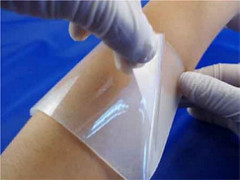Hydrogels are water-based polymers that have the characteristics of both liquids and solids. With their high water content and elastic consistency, they resemble living tissues – making them biocompatible and therefore able to be injected into the body. Some current applications of hydrogels include: contact lenses, disposable diapers, wound dressings, and components in EEG/ECG electrodes.
Image Source: Thomas Trutschel
More recently, chemical engineers at the University of Guadalajara in Mexico have developed a new technology using hydrogels as a way to control the release of anticancer drugs in the body. The researchers injected thermosensitive nano-hydrogels filled with anticancer drugs into patients. The hydrogel’s biocompatible covering protected the drugs from detection and attack by the body’s immune system.
The hydrogels act as a transportation system for the drugs, allowing them to travel directly to the cancer cells they’re meant to destroy without affecting healthy cells. Without the hydrogel covering, the drugs can seriously damage other parts of the body. While inside hydrogels, drugs can be administered in a multitude of ways: oral, nasal, buccal, rectal, transdermal, vaginal, ocular and parental. Hydrogels can be triggered to release their contents by a volume increase, change in pH, or temperature change. Developing temperature-sensitive hydrogels was the focus of this study.
The researchers improved on conventional hydrogels to create polymers that are able to absorb large amounts of water without losing their shape. These hydrogels can also retain heat between 37 and 42 degrees Celsius (98.6 to 107.6 degrees Fahrenheit). Combining emulsion polymerization and microemulsion allowed researchers to create hydrogels that show degrees of swelling, or the extent to which the hydrogel will swell when it absorbs a liquid, and have improved mechanical properties.
Thermosensitive nano-hydrogels show great promise as delivery systems for anticancer drugs because they serve the dual purpose of providing targeted therapy while protecting the rest of the body from the harmful side effects of the drugs.
Feature Image Source: hydrogel-dressing by qeeken1










